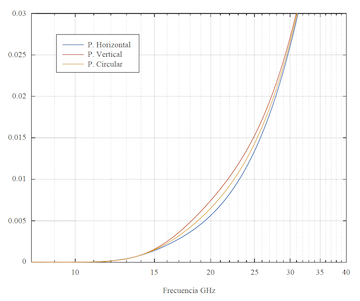Calculation of the Specific Attenuation in Satellite Bands Due to the Rain in the City of Cartagena and its Importance in the Naval Field
DOI:
https://doi.org/10.25043/19098642.204Keywords:
Rain attenuation, rain rate, satellite communicationsAbstract
This work studies the attenuation by rain that occurs in the Caribbean region, specifically, in high frequency bands, considering that modern communication systems make greater use of satellite bands. In this sense, the methodology of the recommendation ITU 838 was used to calculate the radio attenuation by rain in the city of Cartagena (Colombia), for the range of 1-100 GHz, and the data provided by the Center of Oceanographic and Hydrographic Research - CIOH were used as atmospheric information sources. As a result, the attenuation for the first quarter of the analyzed years was observed to be low (2.0x10-2 dB/km), growing in the following months until October (1.0x10-1 dB/km), when it decreases again. This information is particularly useful in the naval field, especially, in relation to the use of these frequencies for information exchange.
Downloads
References
SALOUS, S. Radio propagation measurement and channel modelling, Chichester-England, John Wiley & Sons, 2013. 424 p. ISBN 1118502329, 9781118502327. https://doi.org/10.1002/9781118502280
ZUBAIR, M., HAIDER, M., KHAN, S.A. & NASSIR, J. 2011. Atmospheric influences on satellite communications. Przeglad Elektrotechniczny 87 (5), 261-264.
GARVIN, M. B. Launching Latin America: International and Domestic Factors in National Space Programs. !esis of master's degree. Naval Postgraduate School. Monterey, California, 2014-12.
MANDEEP, J. S., Slant path rain attenuation comparison of prediction models for satellite applications in Malaysia, Journal of Geophysical Research. 2009, Vol. 114, pp.1-12. https://doi.org/10.1029/2009JD011852
NANADRA, A., GOVIL, J. y KAUR, H., Optimization of satellite link design, IEEE SoutheastCon 2008, Huntsville, AL, 2008, pp. 147-152. https://doi.org/10.1109/SECON.2008.4494275
HENRIQUEZ, L. O., DURANTE, C., 2007. Parámetro de radio atenuación troposférica por lluvia para el Estado Zulia en el rango de frecuencias de 0.4 Ghz y 60 Ghz, Télématique, Vol. 6, No. 1, pp.1-16.
KESTWAL, M. Ch., JOSHI, S., GARIA, L. S., Prediction of Rain Attenuation, and Impact of Rain in Wave Propagation at Microwave Frequency for Tropical Region. International Journal of Microwave Science and Technology, 2014, Vol. 2014, pp. 1-6. https://doi.org/10.1155/2014/958498
OROZCO, I., DURANTE, C., 2012. Tropospheric radioattenuation forecast for different angles of elevation in the city of Mérida between 2011 and 2014. Télématique, Vol. 11, No. 1, pp.1-15.
PIMIENTA, C., DURANTE, C., 2006. Niveles de atenuación troposférica en el departamento de la Guajira, Télématique, Vol. 5, No. 2, 2006, pp. 95-109.UIT
Unión Internacional de Telecomunicaciones - UIT. Recomendación UIT-R P.838-3. Modelo de la atenuación específica debida a la lluvia para los métodos de predicción. 1992-1999- 2003-2005.
OZUOMBA, S., Kalu, C. & ONONIWU, G. 2015. Determination of the dominant fading and the effective fading for the rain zones in the ITU-R P.838-3 recommendation. European Journal of Mathematics and Computer Science. 2015, Vol. 2
CIOH. CIOH - OCEANOGRAFIA OPERACIONAL. 2020. [on line]. Available: https://www.cioh.org.co/meteorologia/ResumenClimatologico.php. [Accessed:January 12, 2018]
ALONGE, A. A. & AFULLO, T. J. Rainfall microstructures for microwave and millimeter wave link budget at tropical and subtropical sites, 2013 Africon, Pointe-Aux-Piments, 2013, pp. 1-5, doi: 10.1109/AFRCON.2013.6757852. https://doi.org/10.1109/AFRCON.2013.6757852
AJEWOLE, M. O., KOLAWOLE, L. B. & AJAYI, G. O., !eoretical study of the effect of different types of tropical rainfall on microwave and millimeter-wave propagation, in Radio Science, vol. 34, no. 5, pp. 1103-1124, Sept.- Oct. 1999, doi: 10.1029/1999RS900063. https://doi.org/10.1029/1999RS900063
CARDAMA, A., Antenas, 3rd ed. Barcelona: Universidad Politécnica de Cataluña, 2009, pp. 54-55.

Published
How to Cite
Issue
Section
License
The authors who publish in this Journal certify that:
- The work submitted for publication in The Ship Science and Technology journal, was written by the author, given that its content is the product of his/her direct intellectual contribution.
- All data and references to material already published are duly identified with their respective credits and are included in the bibliographic notes and quotations highlighted as such.
- All materials submitted for publication are completely free of copyrights; consequently, the author accepts responsibility for any lawsuit or claim related with Intellectual Property Rights thereof, Exonerating of responsibility to The Science and Technology for the Development of Naval, Maritime, and Riverine Industry Corporation, COTECMAR.
- In the event that the article is chosen for publication by The Ship Science and Technology journal, the author state that he/she totally transfers reproduction rights of such to The Science and Technology for the Development of Naval, Maritime, and Riverine Industry Corporation, COTECMAR.
- The authors retain the copyright and transfer to COTECMAR the right of publication and reproduction of the work which will be simultaneously subject to the Creative Commons Attribution License (CC -BY) , which allows the license to copy, distribute, display and represent the work and to make derivative works as long as it recognizes and cites the work in the manner specified by the author or licensor.
- For more information about the Creative Commons Attribution License (CC -BY) and his use and scope, please visit the following web page https://creativecommons.org/licenses/by-sa/4.0/legalcode








